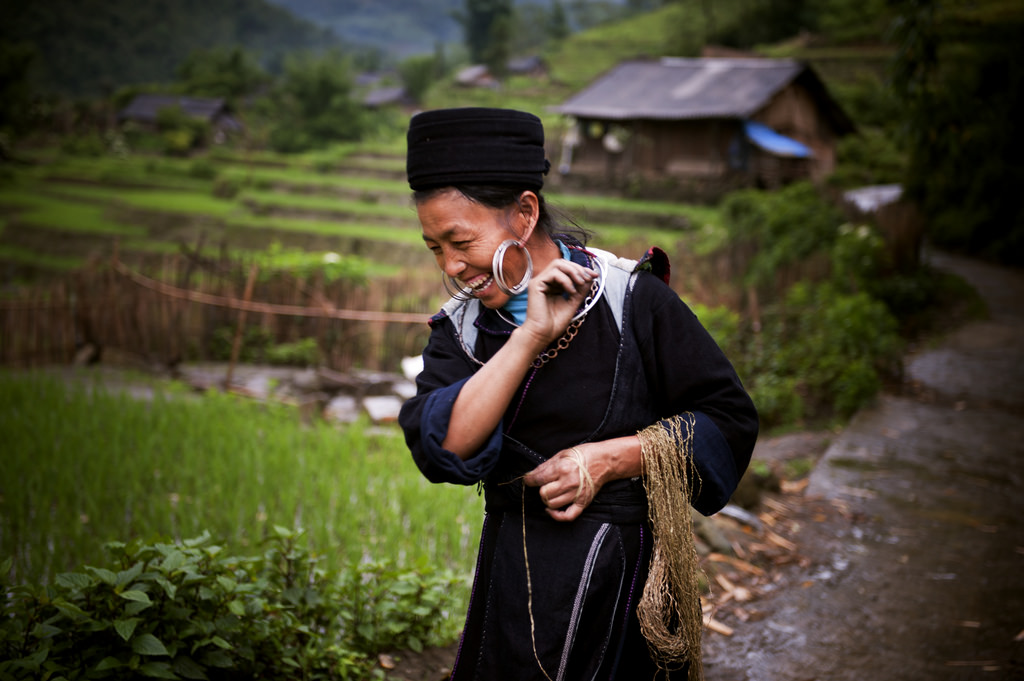
You might also like:
WITHOUT a doubt, Sapa is one of the most beautiful places in Vietnam, if not in southeast Asia. The hillside retreat – also known as the Tonkinese Alps – is celebrated for its sprawling rice terraces, misty peaks, quaint cottages and some of Vietnam’s oldest hill tribes.
You get to encounter Vietnam’s ethnic minorities
A Hmong woman at work. Pic: United Nations Photo/flickr
Sapa is home to some of Vietnam’s oldest ethnic minorities, the biggest of them being Hmong, a group that emigrated from China some 300 years ago. You’ll notice the Hmong people by their dark-colored clothing, silver jewelry and black or blue headgear.
Sometimes, tourists are forbidden to wander into a Hmong village or house, and it’s usually indicated by a green tree branch on the front door.
You might also run into those of the Red Dao group, who arrived in the country not long before the Hmong. The women usually wear colorfully embroidered blouses over trousers while the men commonly don headscarves.
You get to see beautiful colonial architecture

Traditional architecture at Cat Cat Village in Sapa. Pic: Go Vietnam
Because of the region’s colonisation by the French in the late 18th century, there are many signs of French influence in public squares, churches and colonial buildings.
But what’s more unique is the traditional architecture of the local houses built by the many ethnic groups. The Tày houses are built on stilts and are often built with four balconies from all sides to drive the breeze in during the warm summer months.
The houses of the Hmong and Red Dao groups can be spotted in Cat Cat, Lau Chai and Tawan and feature a cultural syncretism of the colonial-era houses and some of the more traditional techniques.
You get to sleep on a hill

Victoria Sapa Resort & Spa
Cat Cat View Hotel has the advantage of some of the most breathtaking views in all of Sapa. The family-run hotel may not be the most luxurious option in the region, but you can’t beat the foggy view of the surrounding mountains from one of the communal terraces.
From Cat Cat View, you can easily walk to villages of the Hmong and Dao people and even embark on a walking or trekking tour led by Hmong people. You can also climb the nearby Mount Fan Xi Pang, the highest peak in Vietnam.
For a more lavish stay, the Victoria Sapa Resort & Spa is a colonial-style mountain chalet whose terraces and balconies open up to sweeping views of the surrounding villages and gardens. The in-house spa offers a variety of massages, body scrubs and reflexology treatments.
You get to hike your way to some of the most rewarding views in Vietnam

Trekking is a popular activity in Sapa. Pic: Vietnam Adventurer
Even if you’re not the trekking type, the sweeping vistas that meet you at the top of your walks might just convert you. But first, it’s worth hiring a guide – preferably of a local ethnic group – to assist in your trek. You can book a guide through your hotel or one of the many tour agents in town.
For more advanced climbers, Mount Fan Xi Pan, Vietnam’s highest peak, takes up to three days to conquer with mountain huts, sleeping bags and tents provided on the way up. You might want to consult local agents for tours if your main purpose to Sapa is to trek.
However, do note that there’s a chance you might not be able to get as clear a view from the pinnacle of Mount Fan Xi Pan on a particularly cloudy day. It’s also important to bring along appropriate footwear as paths can sometimes get rough, wet and muddy.
You get to access it (fairly easily) from Hanoi
Sapa doesn’t have an airport yet, but plans are underway to construct a domestic airport later this year. In the meantime, your best bet to get to Sapa is by an overnight train that departs from Hanoi. The ride takes about eight hours, and is far more comfortable and cheap than taking a bus or renting a car.
Livitrans offers a comfortable ride with each carriage comprising of adequate beds and toilets at only US$35 per way. The trains stop at Lao Cai, while the 30 kilometer transfer from there to Sapa is usually arranged by guests’ respective hotels or taxi.
The post Here’s why you shouldn’t skip Sapa when in Vietnam appeared first on Travel Wire Asia.
Source: travelwireasia.com



